Detrimental Effect Elimination of Laser Frequency Instability in Brillouin Optical Time Domain Reflectometer by Using Self-Heterodyne Detection
Abstract
:1. Introduction
2. Modeling Analysis of Heterodyne Detection Brillouin Signals with Laser Frequency Instability
2.1. Local Heterodyne Detection
2.2. Self-Heterodyne Detection of Rayleigh and Brillouin Scattering
3. Influence of Laser Frequency Instability on Heterodyne Detection Brillouin Spectra
4. Experiment and Discussion
4.1. Local Heterodyne Detection BOTDR System
4.2. Self-Heterodyne Detection BOTDR System
5. Conclusions
Acknowledgments
Author Contributions
Conflicts of Interest
References
- Letokhov, V.S. Laser biology and medicine. Nature 1985, 316, 325–330. [Google Scholar] [CrossRef] [PubMed]
- Balanarayan, P.; Moiseyev, N. Chemistry in high-frequency strong laser fields: The story of HeS molecule. Mol. Phys. 2013, 111, 1814–1822. [Google Scholar] [CrossRef]
- Kikuchi, K. Frequency and phase control of light in coherent optical communication systems. Electron. Commun. Jpn. Part 2 Electron. 1991, 74, 1–10. [Google Scholar] [CrossRef]
- Hong, J.G.; Song, K.Y. Simplified BOTDA system based on direct modulation of a laser diode with an extended measurement range. J. Lightwave Technol. 2015, 33, 1979–1984. [Google Scholar] [CrossRef]
- Kim, S.; Kwon, H.; Yang, I.; Lee, S.; Kim, J.; Kang, S. Performance of a distributed simultaneous strain and temperature sensor based on a Fabry-Perot laser diode and a dual-stage FBG optical demultiplexer. Sensors 2013, 13, 15452–15464. [Google Scholar] [CrossRef] [PubMed] [Green Version]
- Gordienko, V.M.; Koryabin, A.V.; Kravtsov, N.V.; Firsov, V.V. Wind Doppler lidar with 1.5 μm fiber laser. Laser Phys. Lett. 2008, 5, 390–393. [Google Scholar] [CrossRef]
- Vassen, W.; Zimmermann, C.; Kallenbach, R.; Hansch, T.W. A frequency-stabilized titanium sapphire laser for high-resolution spectroscopy. Opt. Commun. 1990, 75, 435–440. [Google Scholar] [CrossRef]
- Maughan, S.M.; Kee, H.H.; Newson, T.P. Simultaneous distributed fibre temperature and strain sensor using microwave coherent detection of spontaneous Brillouin backscatter. Meas. Sci. Technol. 2001, 12, 834–842. [Google Scholar] [CrossRef]
- Tu, G.; Zhang, X.; Zhang, Y.; Ying, Z.; Lv, L. Strain variation measurement with short-time Fourier transform-based Brillouin optical time-domain reflectometry sensing system. Electron. Lett. 2014, 50, 1624–1626. [Google Scholar] [CrossRef]
- Ohno, H.; Naruse, H.; Kihara, M.; Shimada, A. Industrial applications of the BOTDR optical fiber strain sensor. Opt. Fiber Technol. 2001, 7, 45–64. [Google Scholar] [CrossRef]
- Adachi, S. Distributed optical fiber sensors and their applications. Proc. SICE Annu. Conf. 2008, 329–333. [Google Scholar] [CrossRef]
- Feng, X.; Wu, W.; Li, X.; Zhang, X.; Zhou, J. Experimental investigations on detecting lateral buckling for subsea pipelines with distributed fiber optic sensors. Smart. Struct. Syst. 2015, 15, 245–258. [Google Scholar] [CrossRef]
- Texier, S.; Pamukcu, S.; Toulouse, J. Advances in subsurface water-content measurement with a distributed Brillouin scattering fibre-optic sensor. Proc. SPIE-Int. Soc. Opt. Eng. 2005, 5855, 555–558. [Google Scholar]
- Wang, R.; Zhou, L.; Zhang, X. Performance of Brillouin optical time domain reflectometer with erbium doped fiber amplifier. Optik 2014, 125, 4864–4867. [Google Scholar] [CrossRef]
- Geng, J.; Staines, S.; Blake, M.; Jiang, S. Distributed fiber temperature and strain sensor using coherent radio-frequency detection of spontaneous Brillouin scattering. Appl. Opt. 2007, 46, 5928–5932. [Google Scholar] [CrossRef] [PubMed]
- Hao, Y.; Ye, Q.; Pan, Z.; Cai, H.; Qu, R. Influence of laser linewidth on performance of brillouin optical time domain reflectometry. Chin. Phys. B 2013, 22, 074214. [Google Scholar] [CrossRef]
- De Souza, K. Significance of coherent Rayleigh noise in fibre-optic distributed temperature sensing based on spontaneous Brillouin scattering. Meas. Sci. Technol. 2006, 17, 1065–1069. [Google Scholar] [CrossRef]
- Soto, M.A.; Bolognini, G.; Di Pasquale, F. Distributed optical fibre sensors based on spontaneous Brillouin scattering employing multimode Fabry-Perot lasers. Electron. Lett. 2009, 45, 1071–1072. [Google Scholar] [CrossRef]
- Mandel, L.; Wolf, E. Optical Coherence and Quantum Optics; Cambridge University Press: Cambridge, UK, 1995; pp. 900–972. [Google Scholar]
- Li, C.; Lu, Y.; Zhang, X. SNR enhancement in Brillouin optical time domain reflectometer using multi-wavelength coherent detection. Electron. Lett. 2012, 48, 1139–1141. [Google Scholar] [CrossRef]
- Nikles, M.; Thevenaz, L.; Robert, P.A. Brillouin gain spectrum characterization in single-mode optical fibers. J. Lightwave Technol. 1997, 15, 1842–1851. [Google Scholar] [CrossRef]

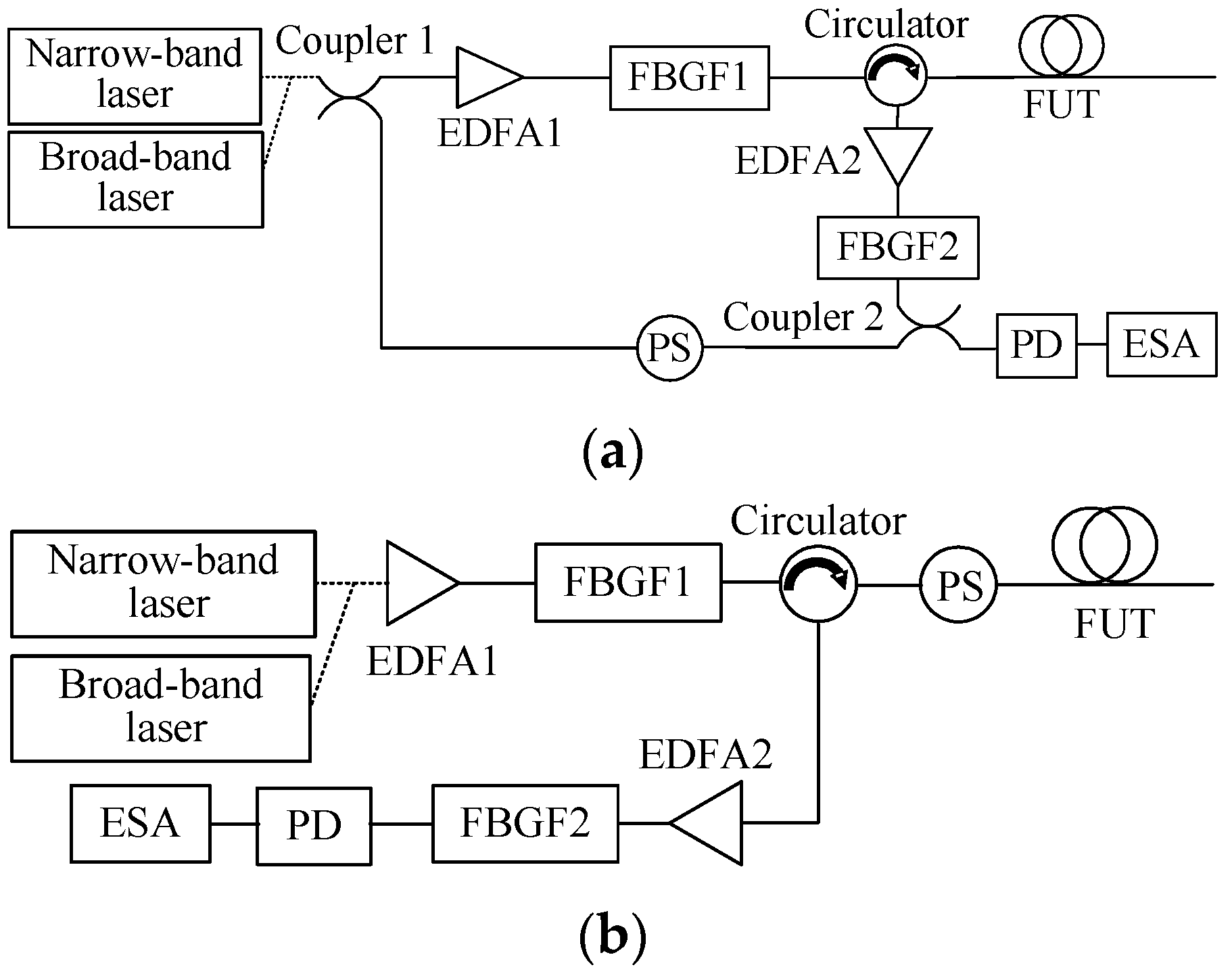
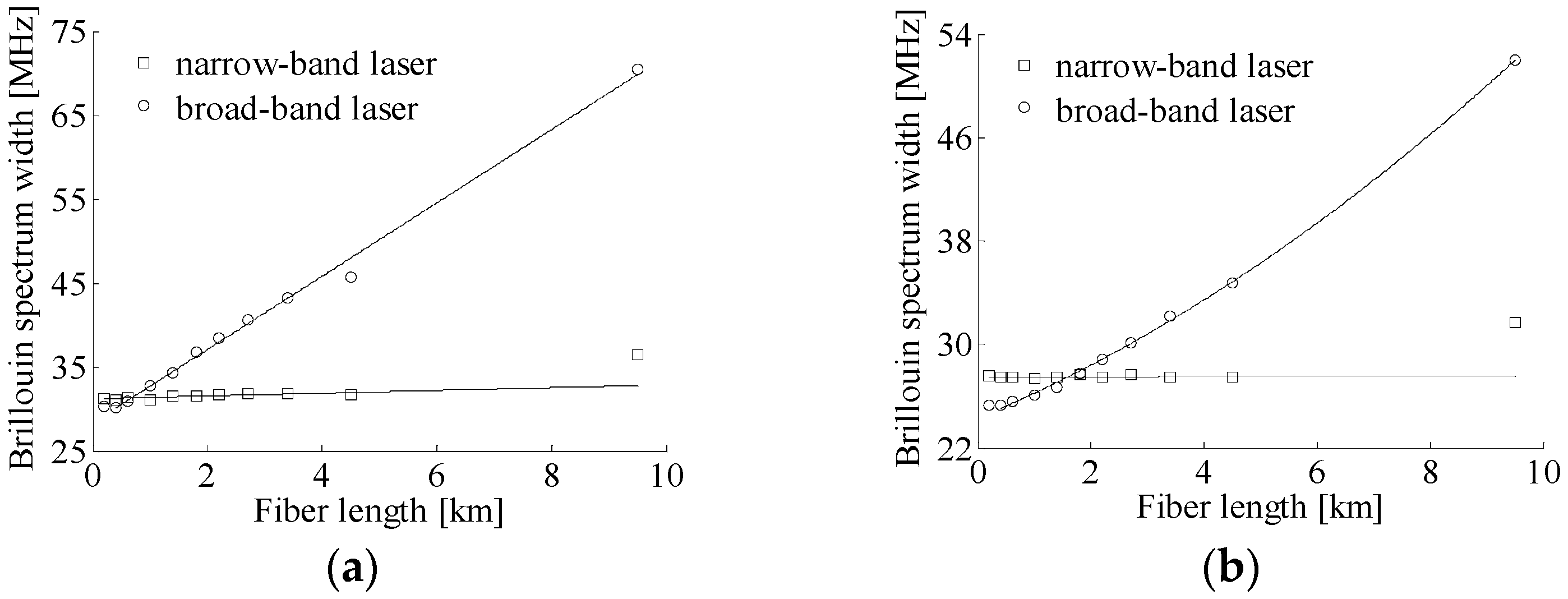
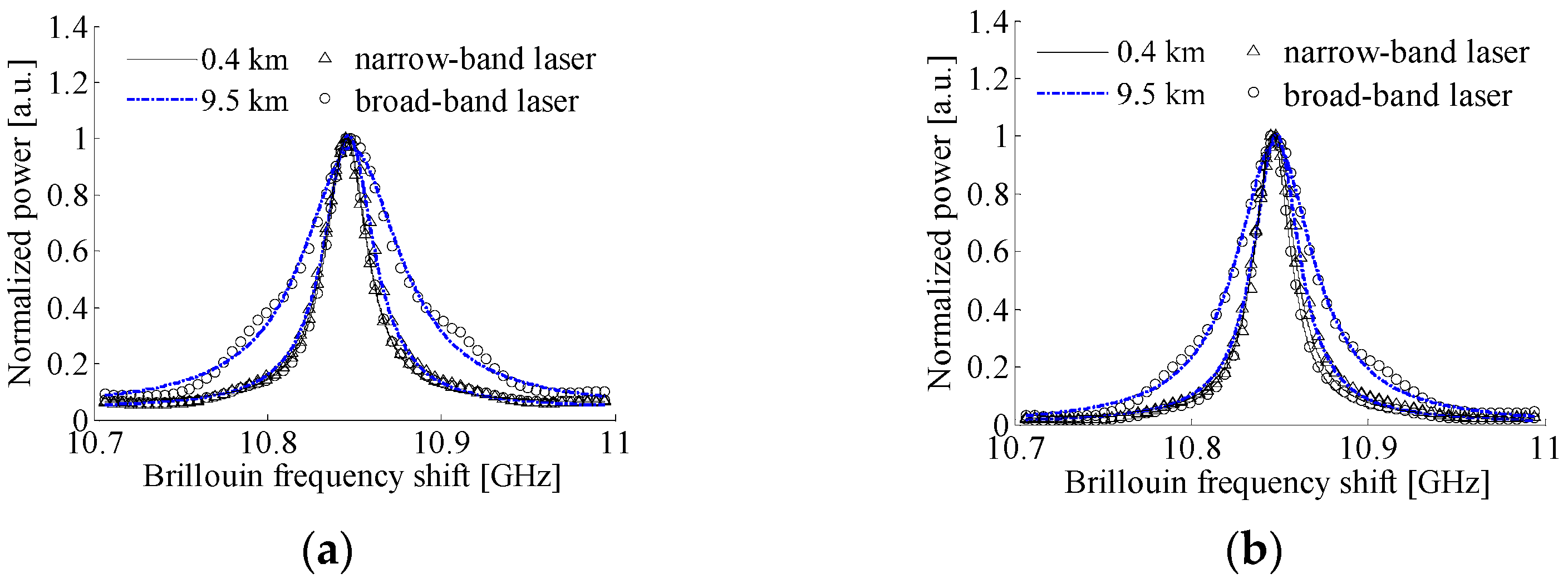

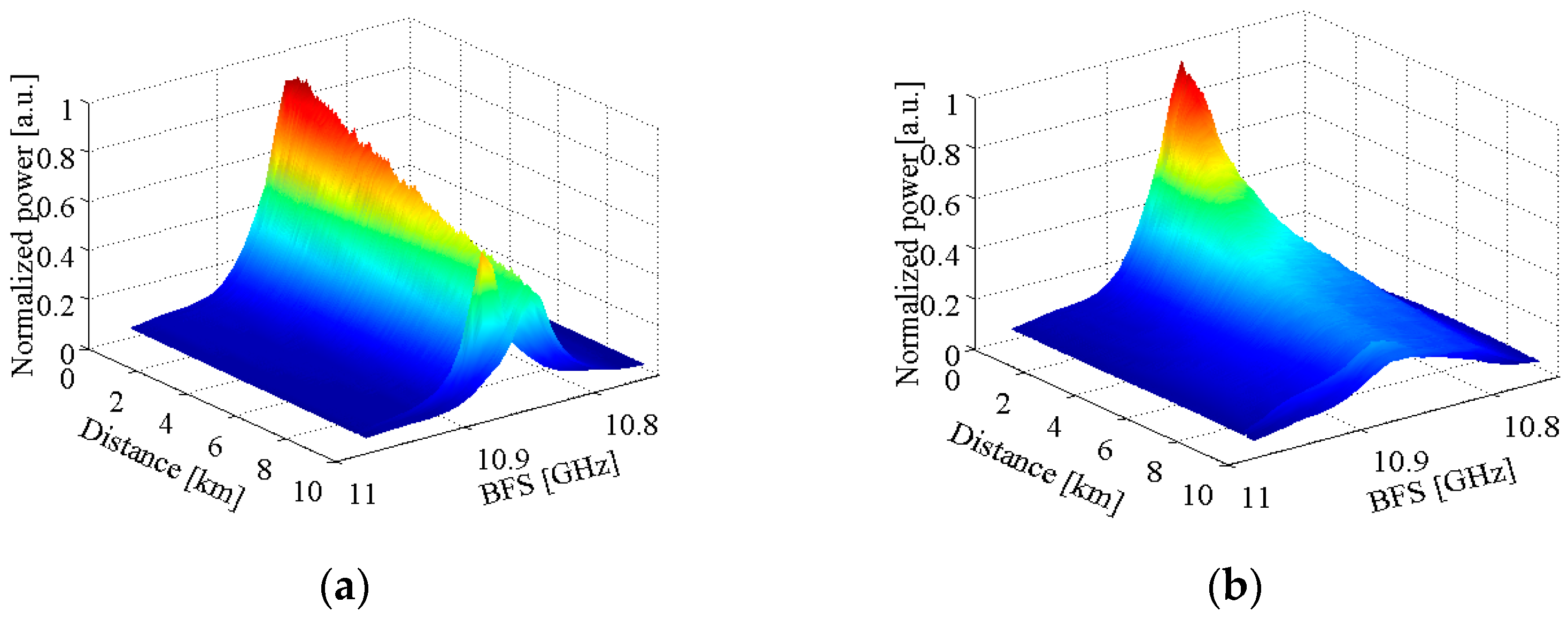
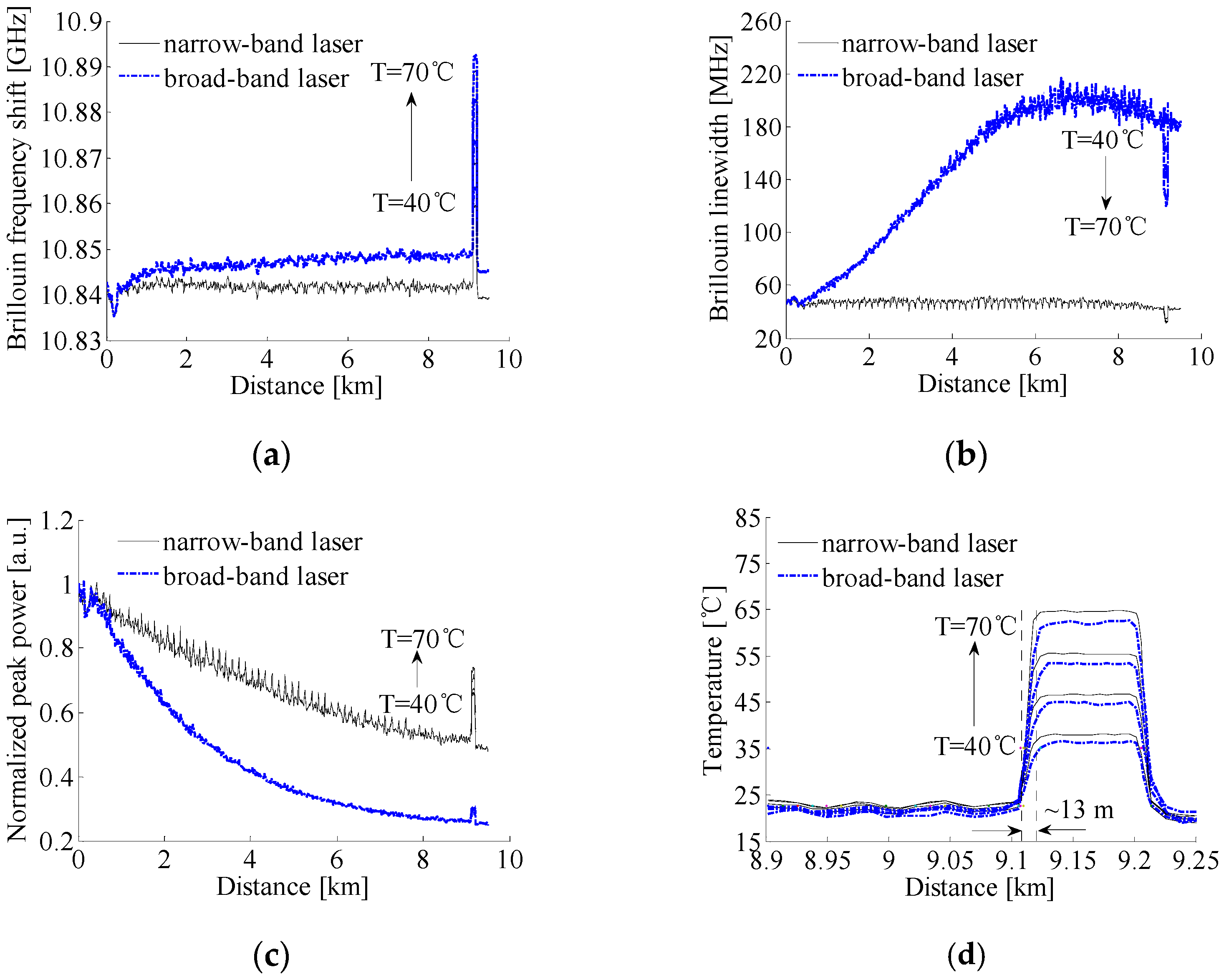

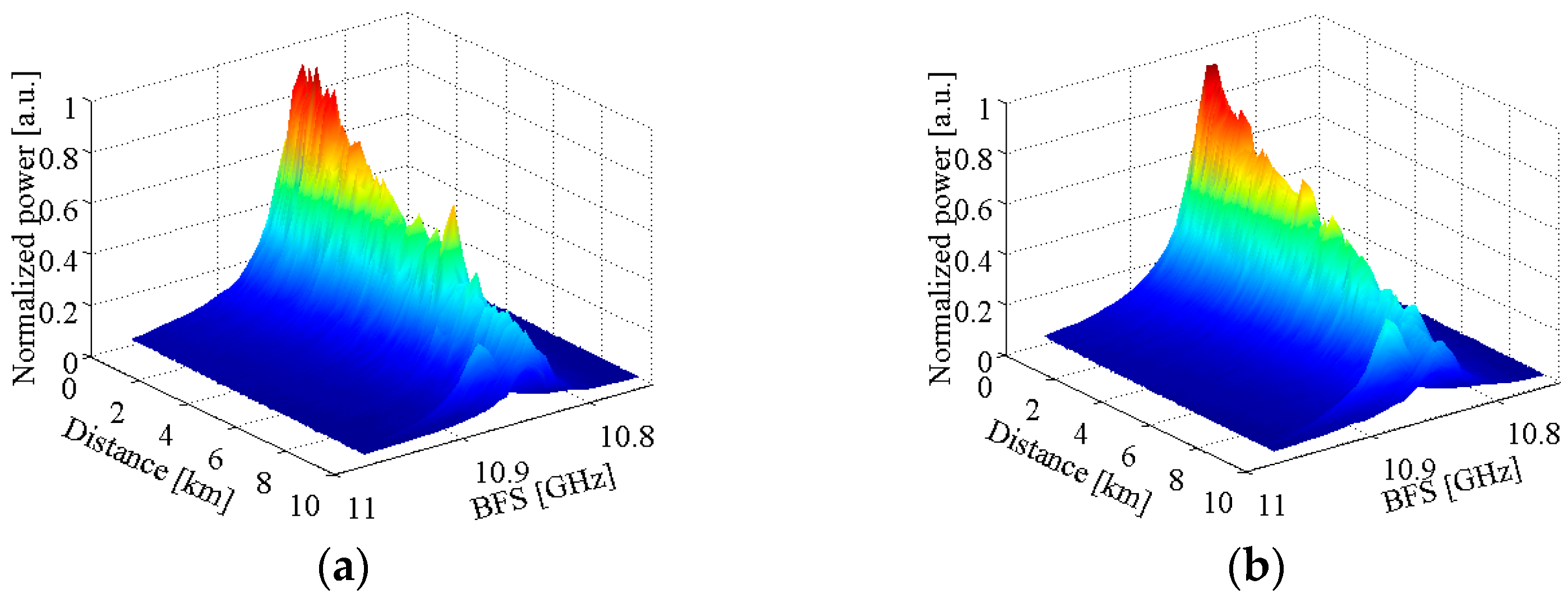


| Fiber length [km] | 0.2 | 0.4 | 0.6 | 1.0 | 1.4 | 1.8 |
| 2.2 | 2.7 | 3.4 | 4.5 | 9.5 |
| Temperature [°C] | Measured Averaged BFS [GHz] | Demodulated Temperature [°C] | ||
|---|---|---|---|---|
| Narrow-Band Laser | Broad-Band Laser | Narrow-Band Laser | Broad-Band Laser | |
| 40 | 10.8594 | 10.8643 | 38.0 | 36.3 |
| 50 | 10.8686 | 10.8733 | 46.6 | 44.7 |
| 60 | 10.8782 | 10.8825 | 55.5 | 53.3 |
| 70 | 10.8880 | 10.8919 | 64.7 | 62.1 |
| Temperature [°C] | Measured Averaged BFS [GHz] | Demodulated Temperature [°C] | ||
|---|---|---|---|---|
| Narrow-Band Laser | Broad-Band Laser | Narrow-Band Laser | Broad-Band Laser | |
| 40 | 10.8585 | 10.8596 | 38.0 | 39.0 |
| 50 | 10.8688 | 10.8701 | 47.6 | 48.8 |
| 60 | 10.8801 | 10.8818 | 58.1 | 59.7 |
| 70 | 10.8909 | 10.8927 | 68.2 | 69.9 |
© 2017 by the authors. Licensee MDPI, Basel, Switzerland. This article is an open access article distributed under the terms and conditions of the Creative Commons Attribution (CC BY) license ( http://creativecommons.org/licenses/by/4.0/).
Share and Cite
Li, Y.; Li, X.; An, Q.; Zhang, L. Detrimental Effect Elimination of Laser Frequency Instability in Brillouin Optical Time Domain Reflectometer by Using Self-Heterodyne Detection. Sensors 2017, 17, 634. https://doi.org/10.3390/s17030634
Li Y, Li X, An Q, Zhang L. Detrimental Effect Elimination of Laser Frequency Instability in Brillouin Optical Time Domain Reflectometer by Using Self-Heterodyne Detection. Sensors. 2017; 17(3):634. https://doi.org/10.3390/s17030634
Chicago/Turabian StyleLi, Yongqian, Xiaojuan Li, Qi An, and Lixin Zhang. 2017. "Detrimental Effect Elimination of Laser Frequency Instability in Brillouin Optical Time Domain Reflectometer by Using Self-Heterodyne Detection" Sensors 17, no. 3: 634. https://doi.org/10.3390/s17030634






